仁爱版英语九年级下册Unit 5 Topic 1 China attracts millions of tourists from all over the world. Section D 课件(
文档属性
| 名称 | 仁爱版英语九年级下册Unit 5 Topic 1 China attracts millions of tourists from all over the world. Section D 课件( |
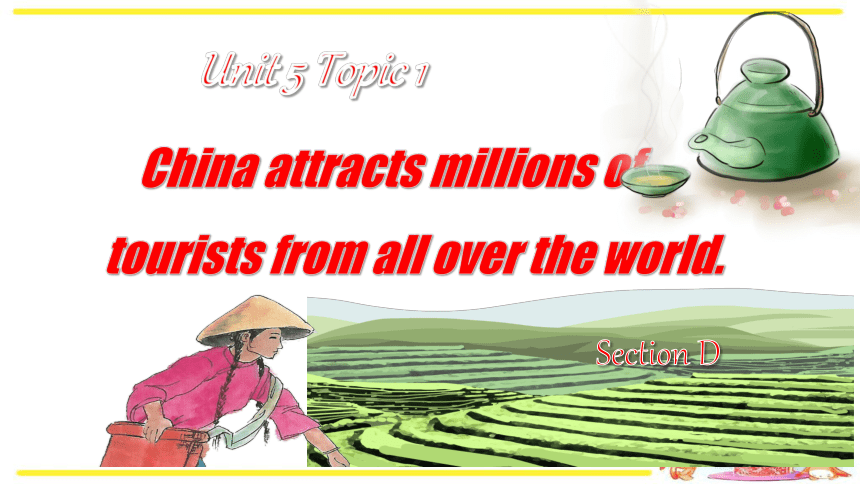
|
|
| 格式 | pptx | ||
| 文件大小 | 11.2MB | ||
| 资源类型 | 教案 | ||
| 版本资源 | 仁爱科普版 | ||
| 科目 | 英语 | ||
| 更新时间 | 2024-01-11 16:31:25 | ||
图片预览

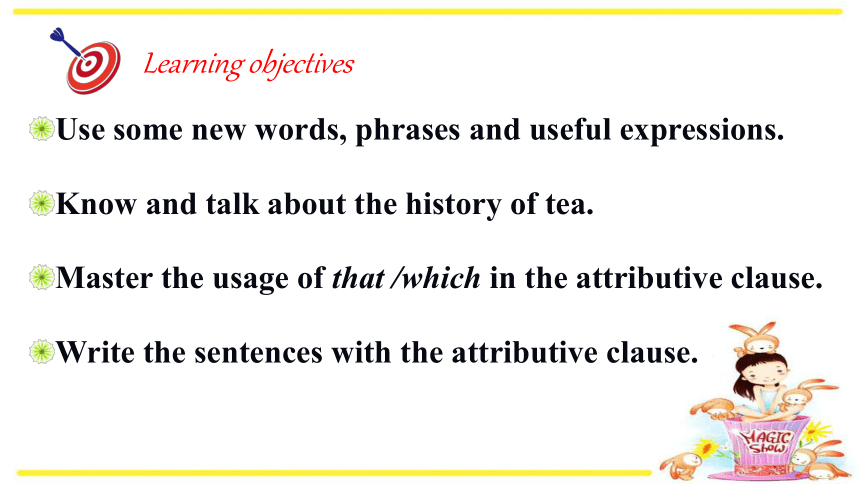
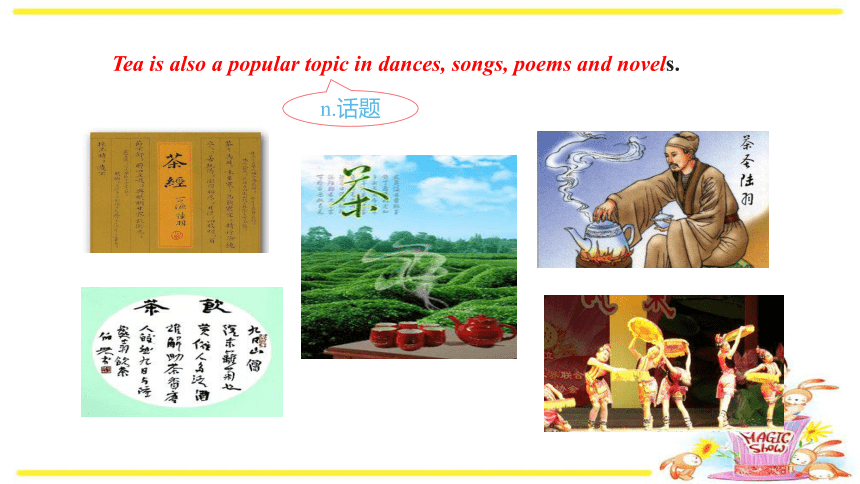
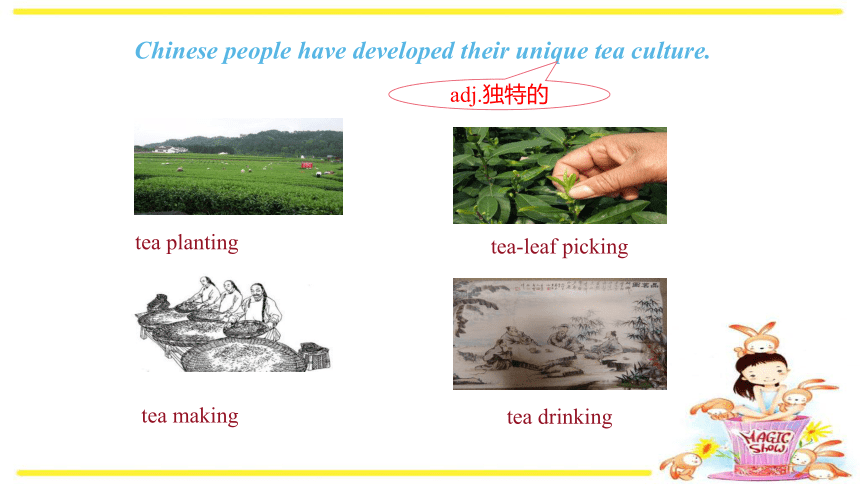
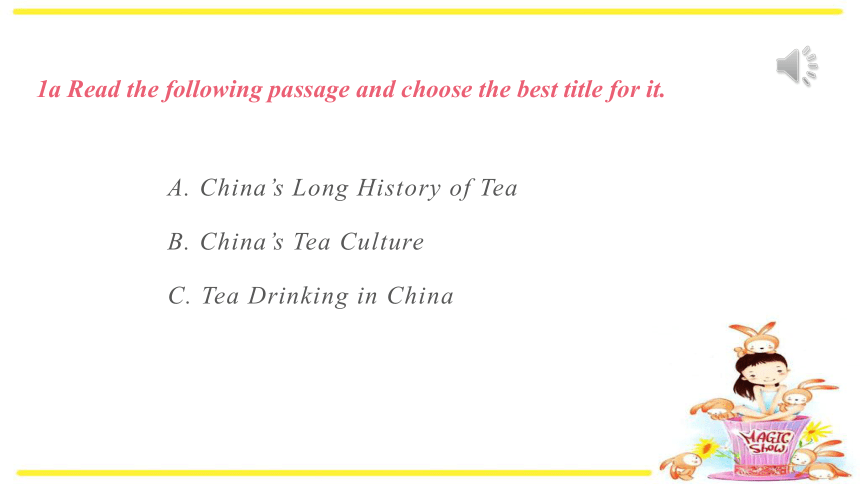

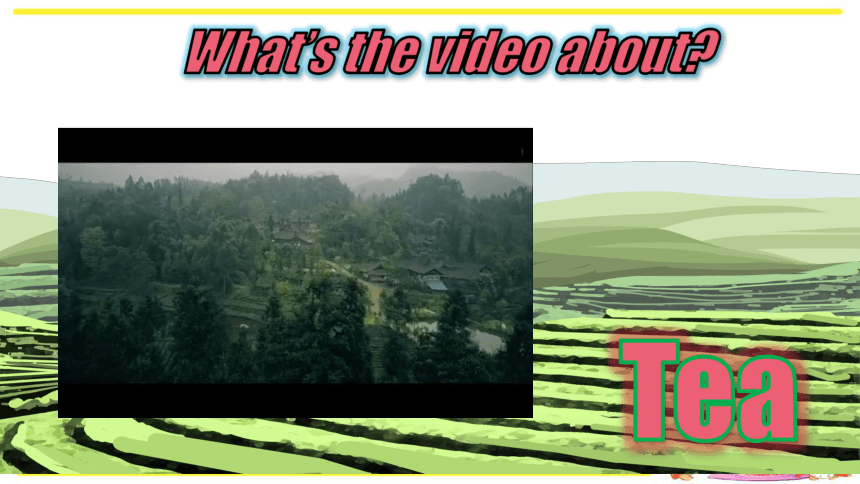
文档简介
(共18张PPT)
Unit 5 Topic 1
Section D
China attracts millions of tourists from all over the world.
Learning objectives
Use some new words, phrases and useful expressions.
Know and talk about the history of tea.
Master the usage of that /which in the attributive clause.
Write the sentences with the attributive clause.
Tea is also a popular topic in dances, songs, poems and novels.
n.话题
Chinese people have developed their unique tea culture.
tea planting
tea-leaf picking
tea making
tea drinking
adj.独特的
1a Read the following passage and choose the best title for it.
A. China’s Long History of Tea
B. China’s Tea Culture
C. Tea Drinking in China
1b Read 1a again and mark T (True) or F (False).
1. Chinese tea became world-famous over one thousand years ago. ( )
2. The sound of the English word “tea” is similar to
that of “chaye” in northern China. ( )
3. The written forms of the word “tea” are totally the same in both Chinese and Japanese. ( )
4. Famous tea leaves in China are produced
mainly in the southern part of the country. ( )
5. Tea drinking is the only part of the Chinese tea culture. ( )
T
F
T
T
F
What’s the video about
Tea
The home of tea, which has more than 4000 years of history, is China. People throughout China drink tea daily. Of the three major drinks — tea, coffee and cocoa, tea is ________ by the largest number of people in the world. Tea from China, along with silk and _________, began to be known by the world over a thousand years ago and has been an important Chinese export since then.
drunk
porcelain
The words for “tea” in different languages came from the Chinese character, “cha”. The English word, “tea”, sounds similar to the pronunciation of it in Xiamen, Fujian Province. The Russians call it “cha’i”, which sounds like “chaye” (tea leaves) as it is ___________ in northern China. The Japanese character for “tea” is written exactly the same as it is in Chinese, thought it is pronounced a little ___________.
differently
pronounced
Read and understand
1a
Tea leaves are produced mainly in the south of China because of the mild climate and rich soil there. Longjing, Pu’er Wulong and Tieguanyin are all famous teas. They’re produced in the provinces of Zhejiang, Yunnan and Fujian.
Over the past centuries, Chinese people have developed their unique tea culture, including tea planting, tea-leaf picking, tea making and tea drinking. Tea is also a popular topic in dances, songs, poems and novels.
1. Tea from China, along with silk and porcelain...
考点
along with 意为“随着; 和… …一起 ”
当主语与along with连用时,谓语动词与along with前面
的主语在人称和数上保持一致。
翻译
那位老师将和他的学生们一起去野炊。
_________________________________________________
The teacher, along with his students, is going for a picnic.
1. Tea from China, along with silk and porcelain...
链接
语法和用法相同的短语:as well as, together with
翻译
空气,还有阳光和水是植物生存所必需的。
_________________________________________________
Air, as well as sunlight and water, is necessary to plants.
这一家人连同他的仆人已经度假两周了。
_________________________________________________
_________________________________________________
The family, together with the servant, have been on a vacation for two weeks..
2a Work in groups to list some unique Chinese tea culture which you know.
2b Translate the following sayings about tea into Chinese and discuss your understanding of them with your partner.
1. The friendship between gentlemen is like a cup of tea.
君子之交淡如水。
2. Firewood, rice, oil, salt, sauce, vinegar and tea are necessary to begin a day.
开门七件事:柴、米、油、盐、酱、醋、茶。
( )1. —Why are you late for the meeting —We took a taxi as soon as we went out. But ______, we still didn’t arrive on time.
A. luckily B. unlucky C. unfortunately( )
2. —Do you know about Florence Nightingale —Yes, she was well-known _____ a nurse in England ____ her kindness to the sick and wounded soldiers.
A. as; as B. for; as C. as; for
3. — I couldn’t find the scarf I bought two days ago.
— ____ It looks nice on you.
A. Not bad. B. What a shame! C. Sounds cool.
Ⅰ. 用所给词的正确形式填空。
1. Tim __________(leave)since 10 years ago.
2. Kangkang, along with his parents, _______ (like)Beijing Opera very much.
3. Over the past centuries, Chinese people _____________ (develop)their unique tea culture.
4. All the students went to the playground _______ (include)Kangkang and Maria.
5. Do you like the books that _______ (be)about Chinese culture
6. Tea _______(drink)by the largest number of people in the world.
7. Tea is produced mainly in _______ (south)China.
8. He talked about many things like tea _______ (plant)and tea _______ (make).
have left
likes
have developed
including
are
is drunk
southern
making
planting
II. 按要求完成句子,每空一词。
1. Cai Lun developed this kind of machines.(改为被动语态)
This kind of machines ____ __________ by Cai Lun.
2. We visited a factory. It makes toys for children.(合并为一句)
We visited a factory __________ _______ toys for children.
3. I suppose you'll have to state it. (改为否定句)
I _____ ________ you will have to state it.
4. 我想读鲁迅写的所有书。 (完成译句)
I want to read all the books _______ ______ Lu Xun.
were developed
that/which makes
don’t suppose
written by
1. Words and phrases:
include, along with, the number of (a number of )
2. Sentences:
1) Of the tree major drinks—tea, coffee and cocoa, tea is drunk by the largest number of people in the world.
2) The friendship between gentlemen is like a cup of tea.
3) Firewood, rice, oil, salt, sauce, vinegar and tea are necessary to begin a day.
Summary
Homework
背A 复习A笔记,完成练习册 A
抄写P81-84 3遍并听/默写1遍
预习B
Unit 5 Topic 1
Section D
China attracts millions of tourists from all over the world.
Learning objectives
Use some new words, phrases and useful expressions.
Know and talk about the history of tea.
Master the usage of that /which in the attributive clause.
Write the sentences with the attributive clause.
Tea is also a popular topic in dances, songs, poems and novels.
n.话题
Chinese people have developed their unique tea culture.
tea planting
tea-leaf picking
tea making
tea drinking
adj.独特的
1a Read the following passage and choose the best title for it.
A. China’s Long History of Tea
B. China’s Tea Culture
C. Tea Drinking in China
1b Read 1a again and mark T (True) or F (False).
1. Chinese tea became world-famous over one thousand years ago. ( )
2. The sound of the English word “tea” is similar to
that of “chaye” in northern China. ( )
3. The written forms of the word “tea” are totally the same in both Chinese and Japanese. ( )
4. Famous tea leaves in China are produced
mainly in the southern part of the country. ( )
5. Tea drinking is the only part of the Chinese tea culture. ( )
T
F
T
T
F
What’s the video about
Tea
The home of tea, which has more than 4000 years of history, is China. People throughout China drink tea daily. Of the three major drinks — tea, coffee and cocoa, tea is ________ by the largest number of people in the world. Tea from China, along with silk and _________, began to be known by the world over a thousand years ago and has been an important Chinese export since then.
drunk
porcelain
The words for “tea” in different languages came from the Chinese character, “cha”. The English word, “tea”, sounds similar to the pronunciation of it in Xiamen, Fujian Province. The Russians call it “cha’i”, which sounds like “chaye” (tea leaves) as it is ___________ in northern China. The Japanese character for “tea” is written exactly the same as it is in Chinese, thought it is pronounced a little ___________.
differently
pronounced
Read and understand
1a
Tea leaves are produced mainly in the south of China because of the mild climate and rich soil there. Longjing, Pu’er Wulong and Tieguanyin are all famous teas. They’re produced in the provinces of Zhejiang, Yunnan and Fujian.
Over the past centuries, Chinese people have developed their unique tea culture, including tea planting, tea-leaf picking, tea making and tea drinking. Tea is also a popular topic in dances, songs, poems and novels.
1. Tea from China, along with silk and porcelain...
考点
along with 意为“随着; 和… …一起 ”
当主语与along with连用时,谓语动词与along with前面
的主语在人称和数上保持一致。
翻译
那位老师将和他的学生们一起去野炊。
_________________________________________________
The teacher, along with his students, is going for a picnic.
1. Tea from China, along with silk and porcelain...
链接
语法和用法相同的短语:as well as, together with
翻译
空气,还有阳光和水是植物生存所必需的。
_________________________________________________
Air, as well as sunlight and water, is necessary to plants.
这一家人连同他的仆人已经度假两周了。
_________________________________________________
_________________________________________________
The family, together with the servant, have been on a vacation for two weeks..
2a Work in groups to list some unique Chinese tea culture which you know.
2b Translate the following sayings about tea into Chinese and discuss your understanding of them with your partner.
1. The friendship between gentlemen is like a cup of tea.
君子之交淡如水。
2. Firewood, rice, oil, salt, sauce, vinegar and tea are necessary to begin a day.
开门七件事:柴、米、油、盐、酱、醋、茶。
( )1. —Why are you late for the meeting —We took a taxi as soon as we went out. But ______, we still didn’t arrive on time.
A. luckily B. unlucky C. unfortunately( )
2. —Do you know about Florence Nightingale —Yes, she was well-known _____ a nurse in England ____ her kindness to the sick and wounded soldiers.
A. as; as B. for; as C. as; for
3. — I couldn’t find the scarf I bought two days ago.
— ____ It looks nice on you.
A. Not bad. B. What a shame! C. Sounds cool.
Ⅰ. 用所给词的正确形式填空。
1. Tim __________(leave)since 10 years ago.
2. Kangkang, along with his parents, _______ (like)Beijing Opera very much.
3. Over the past centuries, Chinese people _____________ (develop)their unique tea culture.
4. All the students went to the playground _______ (include)Kangkang and Maria.
5. Do you like the books that _______ (be)about Chinese culture
6. Tea _______(drink)by the largest number of people in the world.
7. Tea is produced mainly in _______ (south)China.
8. He talked about many things like tea _______ (plant)and tea _______ (make).
have left
likes
have developed
including
are
is drunk
southern
making
planting
II. 按要求完成句子,每空一词。
1. Cai Lun developed this kind of machines.(改为被动语态)
This kind of machines ____ __________ by Cai Lun.
2. We visited a factory. It makes toys for children.(合并为一句)
We visited a factory __________ _______ toys for children.
3. I suppose you'll have to state it. (改为否定句)
I _____ ________ you will have to state it.
4. 我想读鲁迅写的所有书。 (完成译句)
I want to read all the books _______ ______ Lu Xun.
were developed
that/which makes
don’t suppose
written by
1. Words and phrases:
include, along with, the number of (a number of )
2. Sentences:
1) Of the tree major drinks—tea, coffee and cocoa, tea is drunk by the largest number of people in the world.
2) The friendship between gentlemen is like a cup of tea.
3) Firewood, rice, oil, salt, sauce, vinegar and tea are necessary to begin a day.
Summary
Homework
背A 复习A笔记,完成练习册 A
抄写P81-84 3遍并听/默写1遍
预习B
同课章节目录
- Unit 5 China and the world
- Topic 1 China attracts millions of tourists from a
- Topic 2 He is really the pride of China.
- Topic 3 Now it is a symbol of England.
- Unit 6 Entertainment and Friendship.
- Topic 1 I would rather watch sports shows than tho
- Topic 2 Who is your favorite character in literatu
- Topic 3 I will remember our friendship forever.
